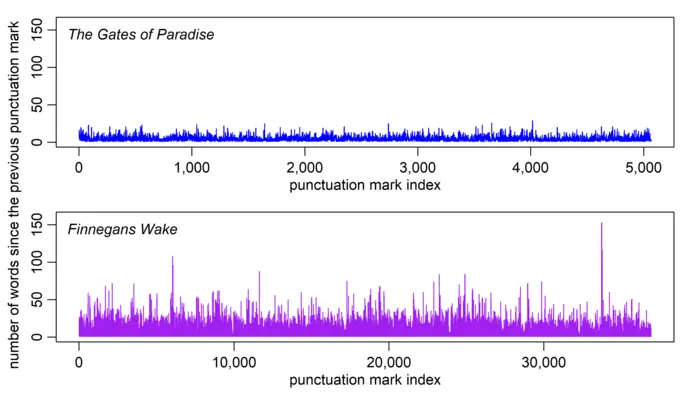New research reveals the unique mathematical structure behind Joyce’s enigmatic masterpiece, challenging our understanding of literary complexity and language patterns.
The Punctuation Puzzle: How ‘Finnegans Wake’ Defies Literary Norms
James Joyce’s “Finnegans Wake” has long perplexed readers with its dreamlike prose and linguistic acrobatics. Now, a groundbreaking study published in the journal Chaos has uncovered a surprising mathematical order within this notoriously challenging work.
Researchers from the American Institute of Physics have discovered that “Finnegans Wake” exhibits a rare and perfectly symmetrical distribution of sentence lengths. This finding sets Joyce’s work apart from other experimental novels and even most natural phenomena.
“‘Finnegans Wake’ exhibits the type of narrative that makes it possible to continue longer strings of words without the need for punctuation breaks,” explains Stanisław Drożdż, lead author of the study. “This may indicate that this type of narrative is less taxing on the human perceptual and respiratory systems or, equivalently, that it resonates better with them.”
Decoding Joyce’s Literary DNA: The Science Behind the Stream of Consciousness
To unravel the mystery of Joyce’s prose, the research team analyzed the spacing between punctuation marks in various experimental novels. They found that most works follow a pattern known as a Weibull distribution, where the probability of encountering punctuation increases as word sequences grow longer.
“Finnegans Wake,” however, breaks this mold. The novel’s wide range of sentence lengths creates a perfectly symmetrical “singularity spectrum” – a mathematical representation of how orderly sentences of different lengths are proportioned.
This level of symmetry is exceedingly rare in nature, suggesting that Joyce’s work possesses a complex, hierarchical structure aligned with the concept of multifractality – a phenomenon where patterns repeat at various scales, like fractals within fractals.
Drożdż notes, “‘Finnegans Wake’ appears to have the unique property that the probability of interrupting a sequence of words with a punctuation character decreases with the length of the sequence. This makes the narrative more flexible to create perfect, long-range correlated cascading patterns that better reflect the functioning of nature.”
Why It Matters
This research offers new insights into the structure of complex literature and human language patterns. Understanding how Joyce achieved this remarkable symmetry could have implications for fields beyond literature, including:
1. Cognitive science: Exploring how the brain processes and creates complex language structures
2. Artificial intelligence: Improving language models to better capture long-range correlations in text
3. Linguistics: Deepening our understanding of the relationships between punctuation, meaning, and readability
The study also raises intriguing questions about the nature of creativity and the potential for mathematical patterns to emerge in seemingly chaotic artistic works.
As we continue to explore the intersection of literature and mathematics, “Finnegans Wake” stands as a testament to the hidden complexities within human expression. Joyce’s ability to craft a work that is both linguistically challenging and mathematically harmonious challenges our perceptions of order and chaos in art.
The research team plans to apply their findings to the development of more sophisticated language models, potentially unlocking new ways to analyze and generate complex texts. As we delve deeper into the mathematical underpinnings of literature, we may discover that even the most avant-garde works contain unexpected patterns waiting to be deciphered.
If our reporting has informed or inspired you, please consider making a donation. Every contribution, no matter the size, empowers us to continue delivering accurate, engaging, and trustworthy science and medical news. Independent journalism requires time, effort, and resources—your support ensures we can keep uncovering the stories that matter most to you.
Join us in making knowledge accessible and impactful. Thank you for standing with us!

